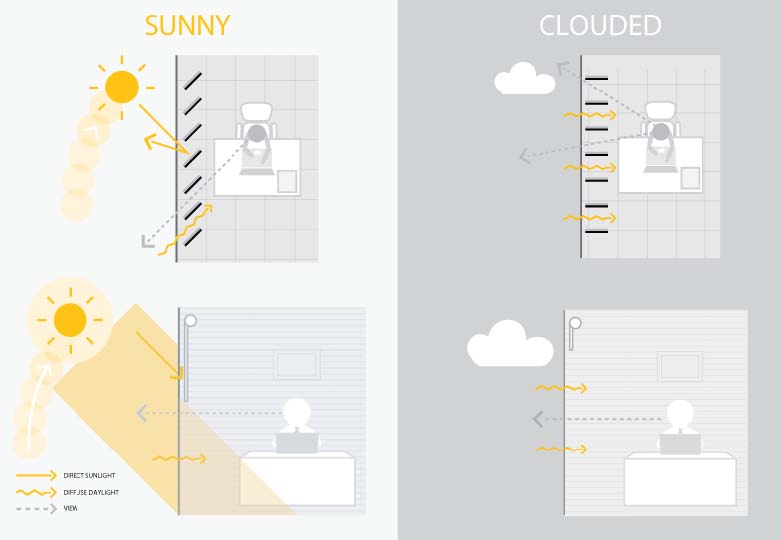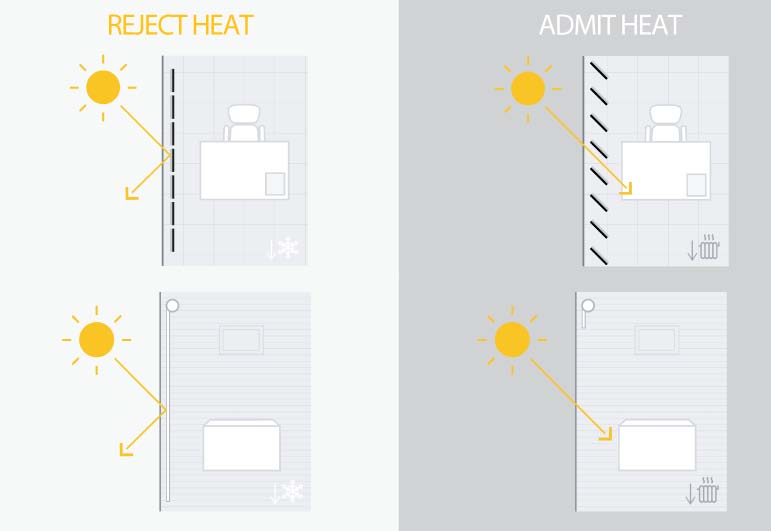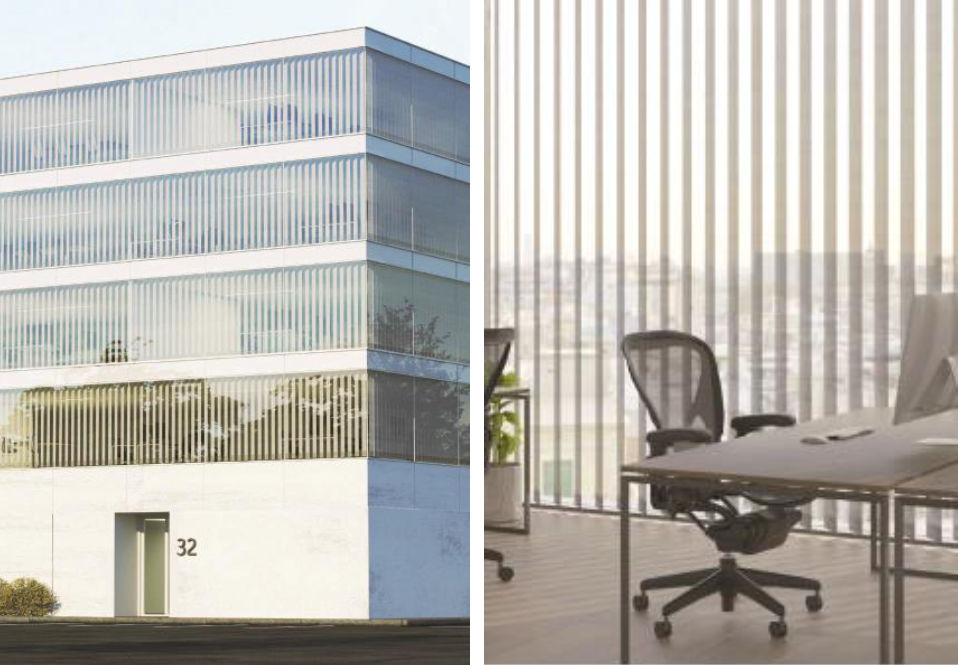Solar Gains Control Systems
Commercial Systems
Kindow Sun-Tracking Verticals and Roller Blinds
By Samuel de Vries, Roel Loonen, Eindhoven University of Technology, The Netherlands and Sam Kin, Kindow, The Netherlands
Product Description
Brief Concept Description
Kindow is a sun-tracking control and motorisation concept for automated indoor roller blinds and vertical blinds. The control concept seeks to balance the competing performance goals of preventing daylight glare, admitting daylight and views to the outdoor, and reducing energy consumption for heating, cooling and lighting.
Kindow utilises metalised shading fabrics which have a very high solar reflectance and allow for low solar heat gains, even though the system is positioned on the inside of the glazing.
The system is operated in relation to the position of the sun, indoor daylight conditions, occupancy, indoor heating/cooling demand, and user preferences. During occupied hours, the system prioritises visual comfort by automatically adjusting the blinds or shades in response to sun position, thereby preventing occupants from perceiving glare from direct sunlight whilst admitting diffuse daylight and views to the outdoors. Under overcast conditions, or when the sun is not in view of the façade, the system fully opens. During unoccupied hours, the control strategy seeks to reduce the energy consumption by admitting and reflecting solar radiation depending on whether solar gains are desirable or not. The operation of the system is shown in Figure 61 and Figure 62.
The Kindow solar shading solutions are developed by the company Kindow B.V. in the Netherlands in close collaboration with Eindhoven University of Technology. The system is currently available on the market and is being continiously improved for both existing and new customers.

Figure 61. Kindow sun-tracking control concept. The illustration shows the operation during occupied hours.

Figure 62. Kindow sun-tracking control concept. The illustration shows the operation during unoccupied hours.
Architectural and Technological Integration into the Envelope
The Kindow shading system can be wired for power supply and communications, but is additionally designed for completely wireless and stand-alone operation. In its stand-alone application, the motorisation system is powered by a PV and battery system which is integrated into the product on the inside of the facade. The control system can be integrated within a larger building automation system but full integration is not required for its operation.
The system, and the employed sensor strategy, is designed in a modular way where the shading system can be controlled in groups. This allows for customized control behaviour for different spaces and façade orientations. The Kindow automation concept can be combined with virtually any type of rollerblind or vertical blinds.
Integration into the Building: System and Comfort
The Kindow system prevents daylight glare discomfort and offers more effective daylight utilisation and views to the outdoors. By preventing the occupant from being exposed to direct solar radiation, the system also helps to prevent thermal discomfort from radiant asymmetry. Compared to conventional automation strategies for rollerblinds, which fully lower or raise the rollerblind in response to an external sensor, the Kindow system offers significant reductions in energy consumption for heating, cooling and lighting. The system allows control parameters to be adjusted to user preferences and the system can be manually retracted. Simulation studies have suggested though that user overrides are less likely to occur compared to a conventional automated control strategy. In comparison to conventional automated control strategies, the Kindow concept is associated with higher solar gains. Compared to a conventional control strategy for indoor rollerblinds, the Kindow system still leads to a reduction in cooling energy consumption as the increase in solar gains is offset by a reduction in heat gains from artificial lighting. In comparison to an automated outdoor solar shading system, the Kindow strategy is associated with a higher cooling energy consumption. This increase in cooling energy consumption is outweighed, however, by reductions in artificial lighting and heating energy consumption in a way that the Kindow system offers more beneficial overall energy performances in terms of final- as well a primary energy consumption.
SWOT Analysis
Strengths
Compared to conventional solar shading systems:
- Reduced daylight glare discomfort and increased admission of daylight, particularly owing to the ‘overcast sky detection’ mode
- More frequent views to the outdoors and less visual disturbance from large and fast shade movements
- Reliefs occupant of manual operation
- Potential for increased user satisfaction and productivity
- Uniform visual appearance
- Control behaviour can be adjusted using sensing and actuation at room, floor or façade level
- Decreases heating and artificial lighting energy consumption
- The sun-tracking behaviour of system offers a very visible investment Compared to automated indoor solutions:
- Increased thermal comfort due to reduced internal heat gains and blocking of direct solar radiation
- Limited additional investment costs
- Decreases cooling energy consumption Compared to automated outdoor solutions:
- Improves reverberation time and more quiet motorisation. Improves acoustic comfort
- Has lower technical and visual impact on the design of the façade
- Can be applied under more extreme conditions (high windspeed and altitude)
- Lower investment, installation and maintenance costs
Weaknesses
Compared to conventional solar shading systems:
- A daylight-dimming system is a required to achieve energy demand reductions. Performance depends strongly on the commissioning of the daylight dimming system
- Improvements in daylighting and energy performance are mainly found within the daylight area of the office space
Compared to automated outdoor solutions:
- In spaces where the indoor climate is verry strongly influenced by solar gains Kindow can have a less favourable effect on thermal comfort than conventionally controlled (fully closed or opened) outdoor shading system with similar optical properties. In such instances the Kindow strategy, wich prioritizes visual comfort, can be associated with higher indoor air temperatures as well as higher surface temperatures (inside glass pane and the shading system).
- Under such conditions the Kindow strategy can lead to more cooling energy consumption than a conventionally controlled outdoor solution. This increase in cooling energy consumption is generally offset however by reductions in the energy demand for heating and lighting.
Opportunity
- The values of integrated daylight management in buildings is increasingly recognized in practice and reflected in standards
- The effects of climate change will increase indoor overheating in buildings. Effective management of daylight and solar gains will become increasingly important
- It can potentially offer reduced investments in glazing and HVAC systems
- It enhances the benefits of highly glazed offices spaces whilst mitigating their weaknesses
- The visual appearance of the system can be customized to a greater extent than outdoor products
- The combination of the indoor Kindow system with static exterior shading elements might offer more beneficial performance than conventional exterior automated shading systems
- The control platform is designed to be extendable. Algorithms based on weather forecasts and self-learning capabiltities are currently being developed
Threats
- Indoor shading solutions are often considered the responsibility of the end-user and not of the developing parties. Potential benefits for developing parties might be overlooked and improvements in comfort and energy performance might not be sufficient argumentation for additional investments
- The performance benefits of indoor products with metallised coatings is still largely overlooked in the building industry
- The performance benefits of indoor shading products and the interactions between daylight controlled lighting and shading control strategies are still not accurately accounted for in many energy standards
- Outdoor solar shading solutions can, in some cases, eliminate/prevent installation of mechanical cooling systems and associated investments. For indoor shading systems this seams less likely
- The effects of climate change will increase indoor overheating in buildings making outdoor solar shading more attractive
Lessons Learned

Figure 63. Kindow vertical blind system. Exterior and interior appearance.
- Advanced solar shading control offers a very cost-effective way of improving indoor environmental comfort and reducing building energy consumption.
- The effects on the indoor environment of solar shading control combined with daylight-driven control of artificial lighting rely on interactions between the thermal and the visual domains of physics. These domains are traditionally adressed seperately within building performance simulation tools. Overcomming this limitation requires specialist knowledge.
- The performance benefits of indoor shading solutions and interactions between artificial lighting and shading systems are not fully recognized by practitioners in the building industry. Solar shading, and especially indoor shading, is often considered to be part of interior furnishing and not as an integral part of the building envelope design. Solar shading specialists are ususally not involved in the early design process and, as a result, the benefits of solar shading are often overlooked.
- There is split incentive between developing parties and end-users which can prevent the potential of solar shading concepts from being realized.
Further Reading
Vries de, S.B., R.C.G.M. Loonen, et al. (2019). Sensor selection and control strategy development support for automated solar shading systems using building performance simulation. Building simulation 2019. Rome.
Woensel van, R. (2018). Automated solar shading and occupant behavior - The impact of occupant behavior modeling on the simulation-based performance prediction of automated solar shading systems. Masters thesis, Eindhoven University of Technology.
Company website